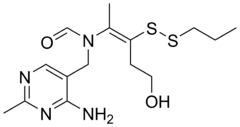Prosultiamine
 | |
 | |
| Clinical data | |
|---|---|
| AHFS/Drugs.com | International Drug Names |
| Routes of administration | Oral |
| ATC code | None |
| Legal status | |
| Legal status |
|
| Identifiers | |
| |
| CAS Number | 59-58-5 |
| PubChem (CID) | 5355019 |
| ChemSpider | 4511078 |
| UNII |
UI32MM3XE3 |
| ECHA InfoCard | 100.000.397 |
| Chemical and physical data | |
| Formula | C15H24N4O2S2 |
| Molar mass | 356.51 g/mol |
| 3D model (Jmol) | Interactive image |
| |
Prosultiamine (Alinamin, Binova, Jubedel, Taketron, Thiobeta, Thiotiamina), also known as thiamine propyl disulfide (TPD), is a disulfide thiamine derivative developed in Japan in the 1950s as a treatment for vitamin B1 deficiency.[1][2] It has improved lipid solubility relative to thiamine and is not rate-limited by dependency on intestinal transporters for absorption, hence the reasoning for its development.[3][4] It is also a potential treatment for HTLV, since it has been shown to reduce viral load and symptoms.[5]
See also
References
- ↑ Swiss Pharmaceutical Society (2000). Index Nominum 2000: International Drug Directory (Book with CD-ROM). Boca Raton: Medpharm Scientific Publishers. ISBN 3-88763-075-0.
- ↑ David J. Triggle (1997). Dictionary of pharmacological agents. London: Chapman & Hall. ISBN 0-412-46630-9.
- ↑ Thomson AD, Frank O, Baker H, Leevy CM (April 1971). "Thiamine propyl disulfide: absorption and utilization". Annals of Internal Medicine. 74 (4): 529–34. doi:10.7326/0003-4819-74-4-529. PMID 5551161.
- ↑ Baker H, Frank O (August 1976). "Absorption, utilization and clinical effectiveness of allithiamines compared to water-soluble thiamines". Journal of Nutritional Science and Vitaminology. 22 SUPPL: 63–8. PMID 978282.
- ↑ Nervous System Disease: A New Outlet for an Old Drug?
This article is issued from Wikipedia - version of the 8/25/2016. The text is available under the Creative Commons Attribution/Share Alike but additional terms may apply for the media files.